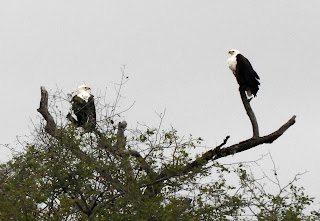 |
| baby elephant trying to reach our hot tub with its trunk |
Victoria Falls is the 4th largest falls in the
world, a long expanse of cliffs with the mighty Zambezi pounding over
them. On our last visit several years
ago, there was so much water, and therefore so much mist, that we couldn’t
really see the Falls from the Zambia side, where we were staying. We were soaked as we walked the circuit along
the Zambian falls, but couldn’t see much more than the water pummeling the
rocks far below the top of the Falls.
 |
| Victoria Falls, Zimbabwe side |
This year, the water is low because of severe drought. We stayed on the Zimbabwean side of the
Falls, at the Victoria Falls River Lodge (which we liked a lot), fortunately,
since the Zimbabwean Falls had a lot of water, while the Zambian side was
completely dry.
The River Lodge is in the Zambezi National Park, home to
large herds of elephants as well as giraffes, antelope, many hippos languishing
in pools in the river, baboons, vervet monkeys, warthogs, crocodiles and
occasionally some cats, which we didn’t see there. The tents of the camp spread out along the
Zambezi, open to the animals, with separate hot tubs (cold water) for each
tent.
 |
| 2 males giraffes fighting |
As we were about to leave for a safari drive our second
afternoon, I looked through our glass door to see 4 large mother elephants and
several babies drinking from our hot tub.
One tiny baby, probably only 2 months old, was trying to get its trunk
into the water, but couldn’t quite reach.
It kept moving its tiny trunk around, getting within inches of the
water, but finally gave up and tried to encourage its mom to let it
suckle. More elephants kept coming up
from the river to drink, so we called our guide to pick us up lest we enrage
one of the huge mama elephants by walking near her baby.
 |
| Sable antelope |
We gathered our group in our Land Cruiser, drove to a
shallow pond in the middle of the camp, and sat there watching as at least 80
elephants flowed around us, drinking, uprooting trees and moving placidly
towards their next foraging spot. It was
the highlight of our animal viewing.
Just amazing to sit in the midst of these huge, intelligent animals and
watch them live their lives, if only for an hour.
Later that day, we were lucky enough to spot some Sable,
very large antelope that I’ve only seen once before, despite having been on
many game drives over the last 10 years.
In a dry ravine, we came upon 2 young male giraffes fighting, which
consists of wrapping their necks around each other and doing a lot of
shoving. It looks like a large giraffe
could easily break a smaller male’s neck, and I guess that does happen, but
rarely, according to our guide.
 |
| hippo resting in the Zambezi River |
There is a great walk through the forest along the Falls,
which we enjoyed. It’s about 2 miles to
the Falls bridge and back, with lots of points for viewing the Falls and the
Zambezi River rapids below. On our way
to Kruger National Park, we walked across the bridge, entering Zambia halfway
across, to take a flight from Livingstone, Zambia, to one of Kruger’s
airports. The bridge crosses a deep
gorge. Walking takes about 10 minutes,
including photo stops, and is a fun way to cross the border. Our van met us on the Zambian side with our
luggage, so an easy transit.
 |
| young elephant and baby sibling |
The Zambezi National Park is relatively small, so doesn’t
have a lot of large predators, but we enjoyed our game drives there very
much. We have stayed at hotels on both
sides of the Falls and, from now on, would always stay inside the Park at one
of the tent camps along the river. Our
guide was excellent and enthusiastic, encouraging us to do longer drives to see
some of the farther parts of the Park, which we really appreciated.
I do think, if you want to see lots of animals, and can only
go to Africa once, East Africa (Kenya’s Masai Mara and Tanzania’s Serengeti and
Ngorongoro Crater) is the place to go.
There are so many more animals there.
When I was there in August with my granddaughter, we saw up to 1000
zebras each day and many thousands of antelope, in addition to lots of lions (27
in the Crater one day alone), leopards, hippos, elephants, giraffes (I love
them) and so much more. In Southern
Africa, where we’ve done safaris in Zimbabwe, Zambia, South Africa and Botswana,
there are fewer tourists, but also many fewer animals. We saw them mostly by the one’s to ten’s,
compared to the dozens to thousands in East Africa.
 |
| sunset over the Zambezi |
Nonetheless, there is so much to see in Southern Africa
besides the game parks that it is well worth a visit.


















































